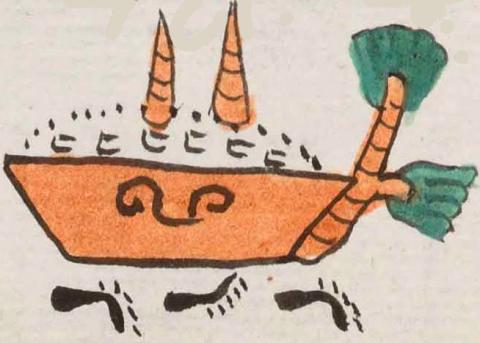Ocpayocan (Mdz23r)
This compound glyph for the place name Ocpayocan includes various elements. Key is the pulque (octli), the alcoholic beverage whose foam (dotted) rises above the bowl that bears the symbol called yacametztli which looks like ram horns but is clearly associated with octli, although not contributing to the phonetic value in this case but only a complement. Protruding up out of the foam are two terracotta-colored points, seemingly meant as roots called (ocpahtli), from which pulque is made (part of the maguey, or metl). To the right of the trapezoid-shaped bowl is a plant with a terracotta-colored trunk and branch and green foliage (possibly an ocotl, pine torch tree, as suggested by Frances Karttunen, and therefore another phonetic complement). Below the bowl are three black footprints, which refer to otli, road, yet another phonetic complement. The locative suffix (-can) is not shown visually.
Stephanie Wood
The phonetic reinforcements in this compound glyph are notable. The road provides the "oh" that is a phonetic indicator for the -yoh suffix that indicates "having the quality of the preceding noun." Note the same role played in Itzteyocan (below, right). Beyond that, the glyph has multiple elements that start with "o," including ocpahtli, octli, and ocotl, and perhaps oppa. To explain the latter, it may be a coincidence that there are two roots popping out of the pulque, but they could lend the phonetic complement oppa (which means twice). Foam was (and still is) a prized aspect of various beverages in Mesoamerican cultures.
The footprints represent the noun for road (otli, providing a phonetic value for the "yo" element, which refers to a place that has a "lot of" something or is "full of" something. This differs from the footprint on top of a hill, which more typically indicates the verb pano (to cross over), providing the phonetic value of the locative suffix -pan, such as can also be seen in the compound glyphs for Tlaltizapan and Xocoyocan. [See Gordon Whittaker Deciphering Aztec Hieroglyphs, 2021, 100.]
Footprint glyphs have a wide range of translations. In this collection, so far, we can attest to yauh, xo, pano, -pan, paina, temo, nemi, quetza, otli, iyaquic hualiloti, huallauh, tetepotztoca, totoco, -tihui, and the vowel "o." Other research (Herrera et al, 2005, 64) points to additional terms, including: choloa, tlaloa, totoyoa, eco, aci, quiza, maxalihui, centlacxitl, and xocpalli.
To see another container of pulque with the same yacametzli symbol on the outside, see Marc Thouvenot's Vignettes, https://vignettes.sup-infor.com/imagen/4-PR_01_254v_f.
Stephanie Wood
Stephanie Wood
c. 1541, or by 1553 at the latest
Stephanie Wood
Counting the octli (beverage in the bowl), ocpahtli (plant roots), pine torch tree (ocotl), and road (otli), there are four, but the glyph is somewhat more complex than this, as the road can double for the "o" in octli and the "yo" just before the locative. And there is a possibility of oppa from the two roots, as mentioned above.
Until all elements are deciphered, it is a challenge to identify the order, but if we accept octli (two, one in the bubbly mixture and another as the symbol on the side of the bowl), pay, otli, and oppa, it is already going down and up and down again.
ocpatli, Ocpahyocan, yacametztli, pulque, bebidas, raíces

ocpa(tli), a plant with a root used for making octli, pulque, Gran Diccionario del Náhuatl, https://gdn.iib.unam.mx/diccionario/ocpatli
oc(tli), pulque, an alcoholic beverage, https://nahuatl.wired-humanities.org/content/octli
o(tli), road, https://nahuatl.wired-humanities.org/content/otli
oppa, twice, https://nahuatl.wired-humanities.org/content/oppa
-yocan, place where there is a lot of (the preceding noun), https://nahuatl.wired-humanities.org/content/yocan
yo(tl), having that characteristic or quality/inalienable possession, https://nahuatl.wired-humanities.org/content/yotl
-can (locative suffix, https://nahuatl.wired-humanities.org/content/can-2
"Ocpahtli Place" [Frances Karttunen, unpublished manuscript, used here with her permission.][Frances Karttunen, unpublished manuscript, used here with her permission.]
"Place Full of Ocpatli" (Berdan and Anawalt, 1992, vol. 1, p. 195)
"El Lugar del Ocpahtli"
Stephanie Wood
Codex Mendoza, folio 23 recto, https://digital.bodleian.ox.ac.uk/objects/2fea788e-2aa2-4f08-b6d9-648c00..., image 56 of 188.
The Bodleian Libraries, University of Oxford, hold the original manuscript, the MS. Arch. Selden. A. 1. This image is published here under the UK Creative Commons, “Attribution-NonCommercial-ShareAlike 3.0 License” (CC-BY-NC-SA 3.0).







